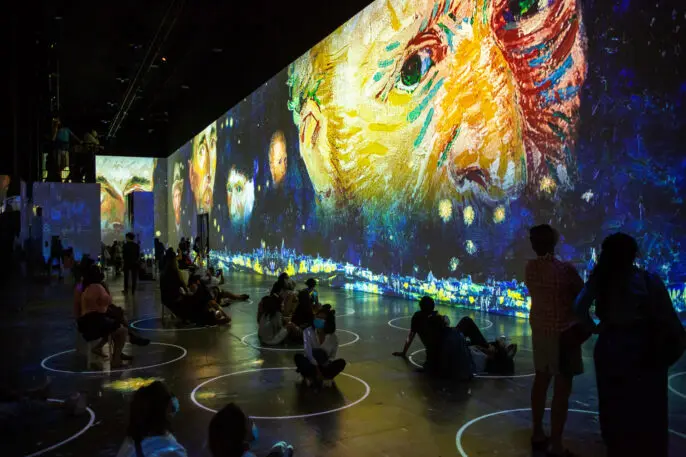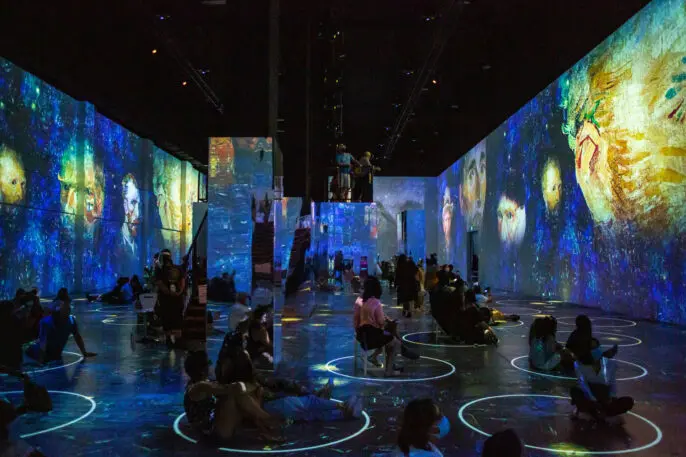In a giant room above a former car dealership in the center of San Francisco, a plethora of huge, brightly colored sunflowers is being laser-projected onto a 27-foot-high wall. Soon, the sunflowers fade into a series of animated swirls, blinking stars, and vivid depictions of the lights of a late-19th-century French village reflected in an undulating river. And then four faces appear—each an upside-down self-portrait of Vincent van Gogh. Standing on a riser about 10 feet above the floor, you feel like you’re deep inside an animated interpretation of one of the famous Dutch artist’s most celebrated paintings, The Starry Night.

Because van Gogh’s work is in the public domain, there are several different “immersive” exhibits showcasing his art making the rounds of the country at the moment. But Dvoretsky says Immersive Van Gogh stands out from the crowd thanks to its singular approach—not simply projecting paintings on a wall, but rather interpreting and deconstructing the work and creating all-new animated representations of 60 van Gogh paintings, including Starry Night, Sunflowers, and The Bedroom. As stated in promotional materials, the exhibit presents the work “as how the artist first saw the scenes they are based on: active life and moving landscapes turned into sharp yet sweeping brushstrokes.”

For the San Francisco version, explains Brandon Charlton, one of the show’s production managers, that meant finding a way to project the 37-minute experience onto the 27-foot-high walls without any shadows getting in the way of what visitors see or having the imagery look in any way anything less than seamless. All told, he says, it took the crew 140 hours to integrate the imagery from 40 laser projectors.
The result is stunning. In the giant room, visitors examine the animation from countless angles—even lying down on the floor and staying as long as they like through multiple plays of the loop—and enjoy crystal-clear imagery composed of 65 million pixels and 56,000 frames of video. Behind the scenes, one master computer is controlling 11 servers, all of which are connected to 8 miles of cable, with the 40 projectors mounted on 510 feet of truss.

“Sensoric experience”
To Dvoretsky, one of the elements that sets Immersive Van Gogh apart from its competition is the way it pairs audio with the animation. The idea was to have music that represents the mood of the imagery, so when the mood changes with the imagery, so too does the music. This creates a “sensoric experience,” she says, that leaves people feeling emotions they may not have expected.
According to Dvoretsky, there are countless self-described van Gogh purists, and many of them come to the show ready to nitpick what they see. Instead, she says proudly, they often leave with new discoveries about van Gogh and his work. “We’re not simplifying the artist,” she says. “We’re opening up new chapters.”

And how do other visitors react to the exhibit? One elderly woman in a wheelchair began crying the moment the show began and was teary-eyed for the entire experience. At the other end of the emotional spectrum, there are several marriage proposals a week.
“We see all kinds of reactions,” Dvoretsky says. “People laying on the floor, people [crying]. And little kids who dance with the music.”
Recognize your brand’s excellence by applying to this year’s Brands That Matter Awards before the early-rate deadline, May 3.
